.
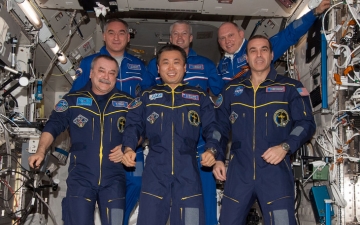
Commander Koichi Wakata of the Japan Aerospace Exploration Agency, Flight Engineer Rick Mastracchio of NASA and Soyuz commander Mikhail Tyurin of Roscosmos, the Russian Federal Space Agency, will wrap up 188 days in space when they depart Tuesday aboard the Soyuz TMA-11M spacecraft that brought them to the station back in November.
.
On the eve of the return to Earth of three crew members after six months in space, the International Space Station’s Expedition 39 crew tackled spacesuit maintenance as well as a full morning of biomedical research for the station’s departing commander on Monday.
Commander Koichi Wakata of the Japan Aerospace Exploration Agency, Flight Engineer Rick Mastracchio of NASA and Soyuz commander Mikhail Tyurin of Roscosmos, the Russian Federal Space Agency, will wrap up 188 days in space when they depart Tuesday aboard the Soyuz TMA-11M spacecraft that brought them to the station back in November. The trio will undock their Soyuz from the station at 6:36 p.m. EDT for a landing southeast of the remote town of Dzhezkazgan in Kazakhstan at 9:58 p.m. (7:58 a.m. May 14, Kazakh time).
NASA Television will provide complete coverage of the Expedition 39 crew’s return to Earth, from farewells to landing.
.
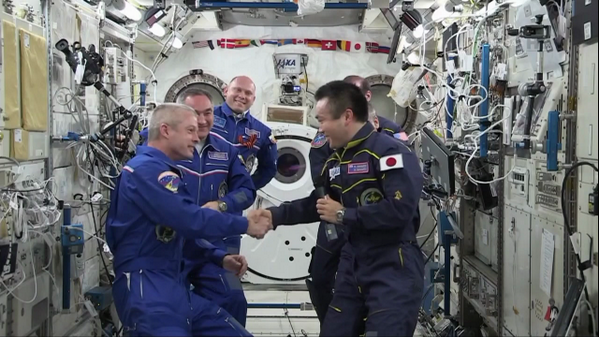
Expedition 39 Commander Koichi Wakata (right) passes the helm of the International Space Station to Expedition 40 Commander Steve Swanson during a change of command ceremony Monday.
.
Quelle: NASA
.
Update: 13.05.2014
.
Frams von ISS-Ceremony vor Rückkehr
.
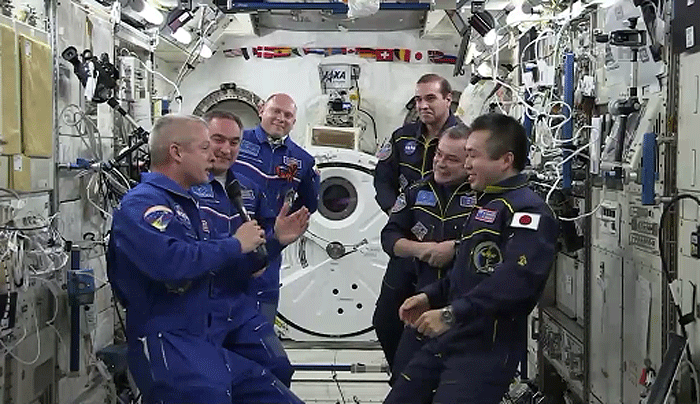
.
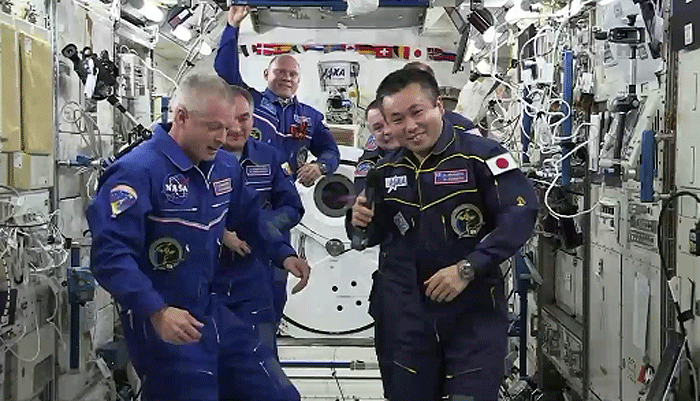
.
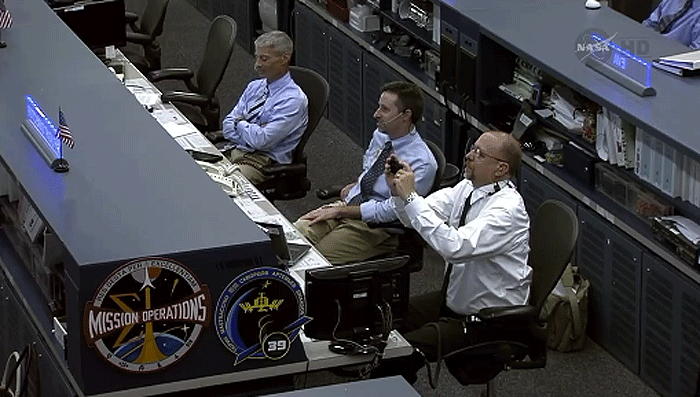
Quelle: NASA
.
MOSCOW, Three crew members from the International Space Station are due to return to Earth on Wednesday morning after 188 days in space, a spokesperson for Russia’s Mission Control Center told RIA Novosti Tuesday.
“Russian cosmonaut Mikhail Tyurin, JAXA astronaut Koichi Wakata and US astronaut Rick Mastacchio will come back aboard a re-entry capsule of the manned Soyuz TMA-11M spaceship,” the spokesperson said.
The Soyuz spacecraft will undock from the ISS early on Wednesday, at 2:35 a.m. Moscow time, before reentering the atmosphere at 5:36 a.m., with the parachute deploying eight minutes later.
The capsule is expected to touch down 148 km southeast of Kazakhstan’s Jezkazgan.
The Soyuz TMA-11M spacecraft carrying a three-man crew and a symbolic torch for the 2014 Sochi Winter Olympic Games docked with the International Space Station on November 7, 2013.
The Rossiya 24 TV channel showed the smiling nine-member crew passing around the unlit Olympic torch in a live broadcast from the ISS.
Quelle: RIA NOVOSTI
.
Update: 14.05.2014
.
Ukraine Krise und ISS
.
Update for 4:50 p.m. ET: NASA officials have seen the reports from Moscow but have received no official notification of any change in the arrangements for operating the space station, agency spokesman Bob Jacobs told NBC News. Activities on the station — including preparations for the return of a U.S.-Russian-Japanese crew aboard a Russian Soyuz spacecraft — have been proceeding as normal, Jacobs said. Here's the written statement issued by NASA on Tuesday:
"We have not received any official notification from Russia’s government regarding any change in our space cooperation. Ongoing safe operation of the International Space Station is expected to continue, including tonight’s return of the Expedition 39 crew and the expected launch of an Expedition 40 crew in two weeks. Space cooperation has been a hallmark of U.S.-Russia relations, including during the height of the Cold War, and most notably in the past 13 consecutive years of continuous human presence onboard the ISS."
Quelle: NBC
.
Departing cosmonauts from among ISS crew transfer to Soyuz spaceship and close the hatches
Russian cosmonaut Mikhail Tyurin, NASA astronaut Richard Mastracchio, and Koichi Wakata, astronaut of Japan's space agency JAXA, who have worked in orbit for more than 187 days, have transferred to the Soyuz TMA-11M spaceship docked with the International Space Station (ISS) and closed the hatches.
Before leaving the ISS, the departing crewmembers said warm goodbyes to Russian cosmonauts Alexander Skvortsov and Oleg Artemyev, and American astronaut Steve Swanson, who will go on working aboard the ISS until September this year.
Within the space of time remaining before undocking, Tyurin, Mastracchio, and Wakata are to check the operation of onboard systems, examine documentation, don spacesuits 'Sokol' (falcon) in the poky descent module of the Soyuz, take up their seats and wait for a command about undocking."
According to plan, the spaceship is to undock from the ISS at 02:36, Moscow time, in an automatic mode. Following separation from the Russian module Zvezda (star), Soyuz crew commander Tyurin will bring the spaceship to a distance of 180-200 m from the station and then steer it towards the Earth.
For more than three hours, automatic equipment will be navigating the spaceship towards a planned landing site located approximately 148 km south east of the Kazakhstani city of Dzhezkazgan.
About 50 minutes prior to landing, at 05:04, at an altitude of about 350 km the Soyuz engine will begin to operate for deceleration. As a result, the spaceship will depart from orbit and start a controlled descent onto the Earth. The parachute of the descent capsule is to open up at an altitude of about 11 km, at 05:44.
Landing is scheduled for 05:58.
Quelle: ITARTASS
.
Soyuz TMA-11M lands in Kazakhstan
A Japanese astronaut, a veteran Russian cosmonaut and a NASA flight engineer strapped into a Soyuz ferry craft, undocked from the International Space Station and fell back to Earth Tuesday, plunging back through the atmosphere for a jarring rocket-assisted landing on the steppe of Kazakhstan to close out a 188-day stay in orbit.
The international crew's return aboard a Russian spacecraft is the first such flight since Russia's annexation of Crimea, the imposition of U.S. and European sanctions and escalating Cold War rhetoric that stands in stark contrast to the close cooperation that has been the hallmark of the International Space Station program.
In the latest space-related tit for tat, Dmitry Rogozin, Russia’s deputy prime minister for space and defense, told Russian news agencies future sales of RD-180 engines, which power the first stage of United Launch Alliance’s Atlas 5 rocket, will not be permitted for launches of U.S. military payloads.
.
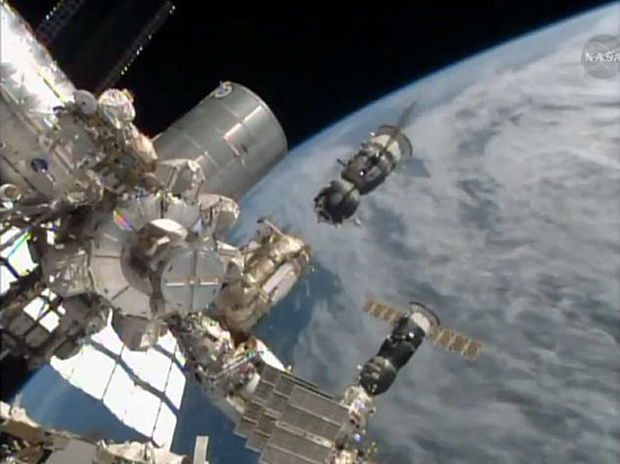
The view from a space station camera as the Soyuz TMA-11M moved away after undocking. (Credit: NASA TV)
.
The Atlas 5 is routinely used for Pentagon missions and its reliance on Russian engines has come under fire in the wake of the Ukraine crisis. ULA competitor SpaceX has argued that payments for the RD-180 violate Obama Administration sanctions, but a temporary injunction was lifted last week based on assurances by the departments of Treasury, State and Justice that the sales were compliant.
In any case, ULA has 16 RD-180s in the United States and it’s not yet known what impact Rogozin's statements about a presumed sales ban might have over the long run.
Both sides say the space station program is not affected by sanctions or other diplomatic hurdles and the Russians continue to honor their lucrative contract with NASA to carry U.S. and partner astronauts to and from the space station aboard Soyuz spacecraft at more than $70 million a seat.
But Rogozin said Russia was not yet committed to operating the space station through 2024 as planned by NASA and the Obama administration. He said any decision to support the lab beyond the previously agreed-on target of 2020 would depend on a cost-benefit analysis, implying extended operations might not be approved.
The Soyuz landing and another Soyuz launch later this month to carry three fresh crew members to the orbital complex highlight NASA's lack of an operational crew-carrying spacecraft of its own and the agency's dependence on the Russians for basic space transportation until at least 2017, when a U.S. ferry craft should be ready for service.
That assumes the program receives the necessary funding from Congress and the station program continues to operate smoothly, with the full cooperation of all the international partners. The station cannot be safely operated by either side without the other.
The station flies 260 miles above the complex geopolitical landscape and from the crew's perspective, the Ukraine crisis has had no impact on day-to-day operations. Entry preparations proceeded normally, the Soyuz TMA-11M spacecraft was successfully checked out and the stage was set for three members of the station's six-man crew to return to Earth.
With commander Mikhail Tyurin at the controls, flanked on the left by flight engineer Rick Mastracchio and on the right by outgoing Expedition 39 commander Koichi Wakata, the Soyuz TMA-11M spacecraft undocked from the Russian Rassvet module at 6:36 p.m. EDT (GMT-4) as the two spacecraft sailed 260 miles above Mongolia.
After moving a safe distance away, Tyurin monitored an automated deorbit rocket firing, a four-minute 41-second "burn" designed to slow the spacecraft by about 286 mph, just enough to drop the far side of its orbit deep into the atmosphere.
.
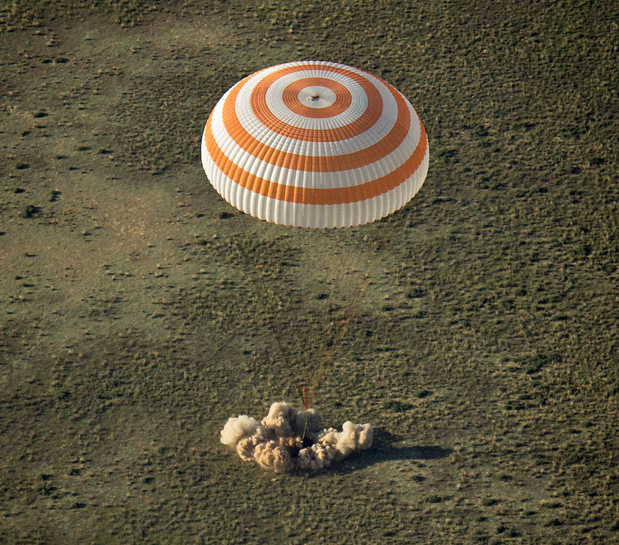
NASA photographer Bill Ingalls captured the moment of landing an instant after the Soyuz TMA-11M spacecraft's braking rockets fired. (Credit: NASA)
.
A half-hour later, just before reaching the top of the discernible atmosphere at an altitude of about 62 miles, the three modules making up the Soyuz TMA-11M spacecraft separated, leaving the heat shield-equipped central crew cabin on its own for a northeasterly descent toward the landing site in Kazakhstan.
After plunging to an altitude of just under seven miles, the crew compartment's main parachute unfurled to slow the descent even more and a few minutes later, the crew module settled to a jarring rocket-assisted touchdown near the town of Dzhezkazgan at 9:58:30 p.m. (7:58 a.m. Wednesday local time).
Landing marked the final chapter in a mission covering 3,008 orbits and 79.7 million miles since launch Nov. 6.
"I was a flight engineer on the space shuttle, but I didn't have my own set of controls,” Mastracchio said in a pre-launch interview. “Here in the Soyuz, I'm also the flight engineer but I'm actually going to be helping control the vehicle along with the commander.
"So I'm looking forward to having that front row seat, if you will, and actually helping operate the vehicle."
Learning how to operate a spacecraft is challenging under any circumstances. It was especially tough to do in a second language.
"It's very, very challenging," Mastracchio said. "Being an engineer, I have the skills to learn how to fly a vehicle and how to operate a vehicle, but the language skill was very challenging for me. It's not as easy as it sounds to fly a spacecraft while speaking a foreign language! Again, a big challenge, which made it very interesting to me."
As usual with Soyuz landings, Russian recovery forces deployed near the landing site reached the spacecraft within a few minutes to help the returning space fliers get out of the cramped crew module as they began the process of re-adapting to Earth's gravity after six months in weightlessness.
In keeping with Russian traditions, Tyurin, Mastracchio and Wakata were carried from the capsule to nearby recliners where they could relax, enjoy their first fresh air in months and make satellite phone calls to friends and family. All three looked relaxed and in good spirits.
Tyurin has now logged 532 days in space during three space flights, moving him up to 13th on the list of most experienced space fliers. Wakata's total through two shuttle flights and a previous station stay increased to 348 days while Mastracchio's numbers, including three shuttle flights, climbed to 228 days.
.
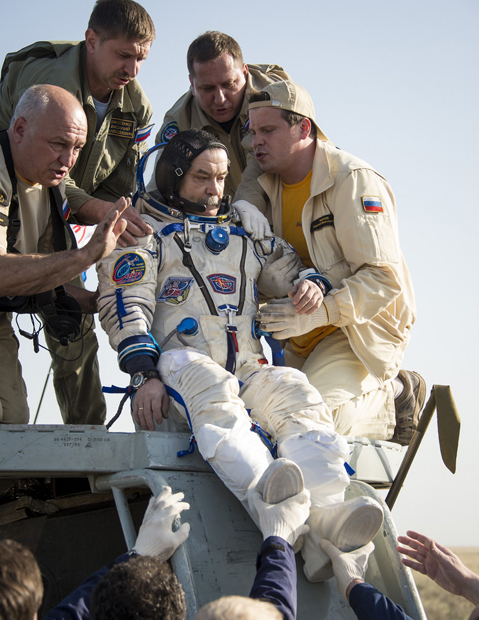
Soyuz commander Mikhail Tyurin is helped out of the descent module after landing in Kazakhstan. (Credit: NASA)
.
After initial medical checks, all three were expected to board Russian helicopters for a short flight to a staging base in Karaganda. From there, Mastracchio and Wakata planned to board a NASA jet for the long flight back to the Johnson Space Center in Houston while Tyurin heads home to Star City near Moscow.
During the course of their stay aboard the station, Tyurin, Mastracchio and Wakata delivered an Olympic torch to celebrate the 2014 Winter Games in Sochi and Mastracchio participated in three spacewalks, two to repair the station’s cooling system and one to replace a balky computer.
The crew also carried out extensive troubleshooting to recover from a potentially catastrophic spacesuit water leak last summer and operated a full slate of scientific experiments.
Left behind in orbit were Expedition 40 commander Steven Swanson, Soyuz TMA-12M commander Alexander Skvortsov and flight engineer Oleg Artemyev. They will have the space station to themselves until May 28 when Soyuz TMA-13M commander Maxim Suraev, NASA flight engineer G. Reid Wiseman and European Space Agency astronaut Alexander Gerst blast off from the Baikonur Cosmodrome in Kazakhstan for a planned four-orbit flight to the lab.
The space station is generally healthy, but engineers are continuing to troubleshoot an electrical glitch last week that took down one of the eight electrical power channels driven by the lab's U.S. solar arrays.
Equipment on channel 3A, including the Alpha Magnetic Spectrometer and an experimental laser communications package, briefly lost power but flight controllers quickly switched affected systems to channel 3B without any major impact.
It is not yet clear what caused the remote bus isolator to "trip open" May 8, but a similar problem occurred in 2012 and engineers are reviewing telemetry to determine how to restore channel 3A to normal operation.
.
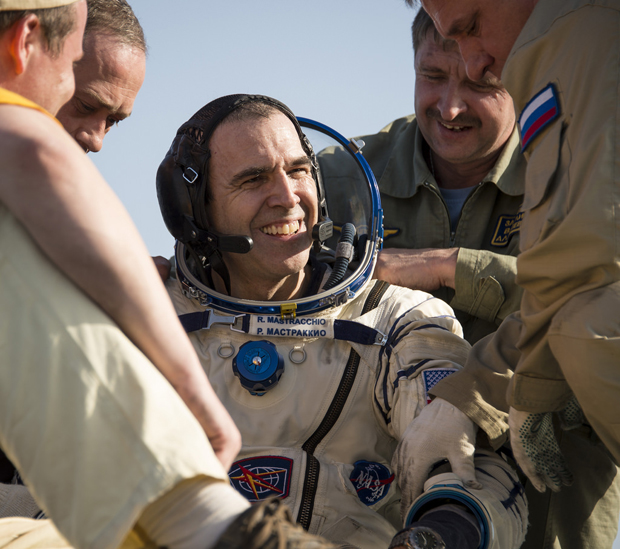
NASA flight engineer Rick Mastracchio chats with recovery crews after being helped from the Soyuz TMA-11M spacecraft following landing in Kazakhstan to close out a 188-day mission. (Credit: NASA)
.
During a change-of-command ceremony Monday, Wakata, a shuttle veteran and the first Japanese to command the space station, thanked his crewmates for "an exciting time" in orbit.
"I had the honor of serving as commander, which was an incredible opportunity for me to extend my knowledge and experience in managing this complex outpost of humans in space," he said. "And I couldn't have done this job without the superb performance of my fellow crewmates."
Turning over command to Swanson, a former shuttle crewmate, Wakata offered his "congratulations and best wishes for a successful mission."
Swanson returned the praise, thanking Wakata, Tyurin and Mastracchio for sharing their experience.
"When we first got here, you guys were very kind to us, you gave us so much friendship, it meant so much to us," Swanson said. "And it makes it a little bit of a sad moment for me, because I've come to grow to like you guys very much. I would wish we could be up here for a long time, but I know you have to go.
"But again, thank you all for the experience you guys have given us, the knowledge you have given us. You have together a combined 11 spaceflights and over three years of time in space, which is just amazing, and that knowledge you have given us is fantastic. I really appreciate it."
Swanson then spoke to Wakata personally, saying "your leadership was fantastic."
"You set an example that will be very hard to match," Swanson said. "Your diligence, your endless energy, your desire to make the station as best as it possibly could be was just a pleasure to watch. I'm truly very proud to have been a part of your crew."
Quelle: CBS
.
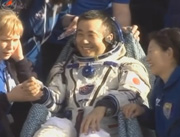
"Welcome home Astronaut Wakata!" Safe return to Earth
The Soyuz spacecraft (TMA-11M/32S) with three crewmembers including Astronaut Wakata onboard safely landed in the Republic of Kazakhstan at 10:58 a.m. on May 14 (Wed.)
Astronaut Wakata began his long stay at the International Space Station (ISS) on Nov. 7, 2013, as a crewmember of the Expedition mission 38/39, and performed various activities focusing on space environment utilization including ISS operations, system management for each ISS facility including the Japanese Experiment module “Kibo,” and science experiments.
During the latter half of his stay as Expedition 39, Astronaut Wakata became the first Asian commander of the ISS and led life on the ISS for 66 days from March 9.
Thank you very much for your support to his long stay of about six months.
Quelle: JAXA
.
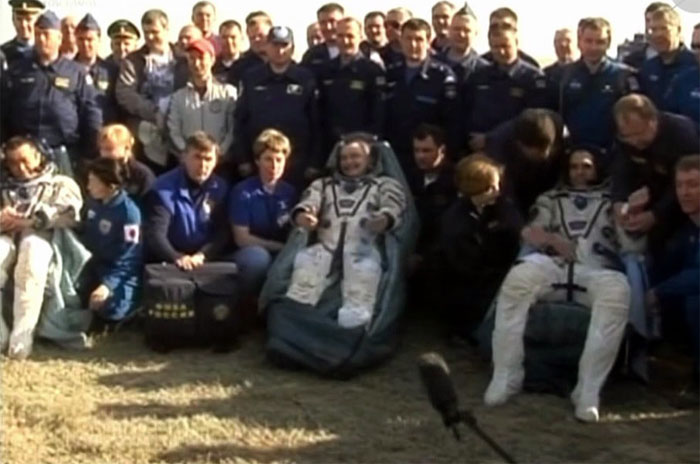
The Expedition 39 crew adjusts to the full force of Earth's gravity shortly after landing in Kazakhstan aboard their Soyuz spacecraft.
Image Credit: NASA TV
.

The Soyuz TMA-11M spacecraft backs away from the International Space Station shortly after undocking.
.
Quelle: NASA
.
Astronaut Wakata , 1st Japanese commander of ISS, returns to Earth
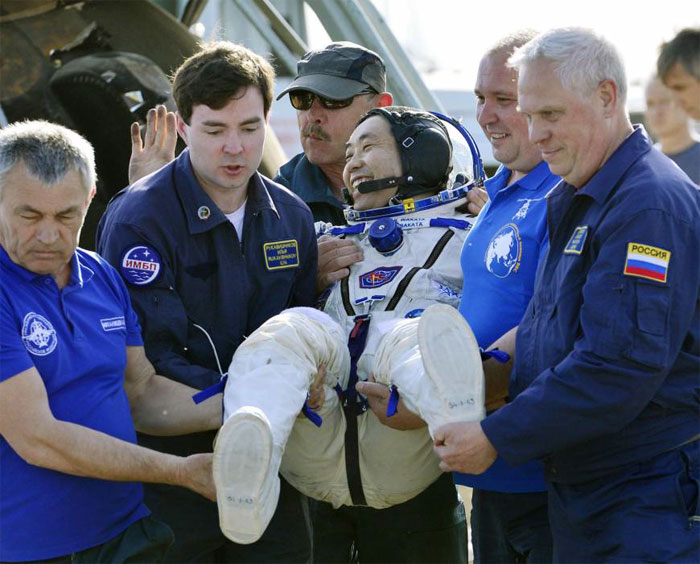
Koichi Wakata is carried out of the Russian Soyuz after the space capsule carrying him and two other astronauts landed Wednesday in the steppes of Kazakhstan.
.
Astronaut Koichi Wakata, the first Japanese commander of the International Space Station, returned to Earth on Wednesday after completing a six-month mission.
Wakata, 50, landed in Kazakhstan aboard a Russian Soyuz spacecraft, after handing his duties as ISS commander, which he assumed in March, to U.S. astronaut Steven Swanson. He served as the station’s skipper for 66 days.
Swanson and cosmonauts Alexander Skvortsov and Oleg Artemyev will manage the station, a $100 billion project of 15 nations, until new crewmates arrive on May 28.
Wakata was the first Asian to head the station, where he worked with five other astronauts from the United States and Russia, including NASA astronaut Rick Mastracchio and Russian cosmonaut Mikhail Tyurin.
It was Wakata’s fourth trip to space, where he spent 188 days on this mission. It was the longest stay by a Japanese astronaut in a single voyage, surpassing the 167 days previously spent by Satoshi Furukawa.
Wakata’s total time in space across his four trips has reached 348 days, also the longest for a Japanese and followed by Soichi Noguchi’s 177 days.
While aboard the ISS, Wakata filmed Comet ISON with a 4K high-resolution camera, the Japan Aerospace Exploration Agency said.
Wakata joined the ISS in November, 2013, and became the station’s 39th commander on March 9 this year. Typical command duties include giving orders in the event of a fire or meteor strike.
To date, most commanders have been selected from the United States and Russia because those two countries lead the ISS project, but Canadians and Europeans have also headed the ISS.
Japan provides one unit of the ISS, a science laboratory named Kibo. In a ceremony marking the transfer of command, the crew gathered at the Japanese module.
“I had an honor of serving you as commander, which was an incredible opportunity for me to expand my knowledge and experience in managing this complex outpost of humans in space, and I couldn’t have done this job without the superb performance of my fellow crew-mates and great teamwork,” Wakata said.
Until Tuesday, the station partnership, headed by the United States and Russia, had been relatively untouched by the rhetoric and economic sanctions stemming from Russia’s annexation of Ukraine’s Crimea peninsula. But the program’s protected status shifted after Dmitry Rogozin, Russia’s deputy prime minister for space and defense, told news agencies on Tuesday that he would not support a U.S. and European proposal to extend the space station beyond 2020.
Rogozin, who is among 11 Russian officials sanctioned by the United States, also said he would ban the sale of Russian-made rocket engines, which are used to launch U.S. military satellites. United Launch Alliance, a partnership of Lockheed Martin and Boeing, use the Russian-made RD-180 engines to power the first stage of its Atlas 5 rockets.
Apparently exempt from Rogozin’s ban are Soyuz flight services, currently the only means of transporting crew to the space station following the retirement of the U.S. space shuttles in 2011. NASA pays Russia more than $60 million per person to fly its astronauts on Soyuz capsules and is expected to continue to do so until at least 2017.
NASA is reviewing proposals from at least three U.S. companies to develop a commercial space taxi, with the aim of breaking the Russian monopoly on crew flight services by 2017. The U.S. space agency had no immediate comment in response to Rogozin’s announcement.
Quelle: The Japan Times
5225 Views
